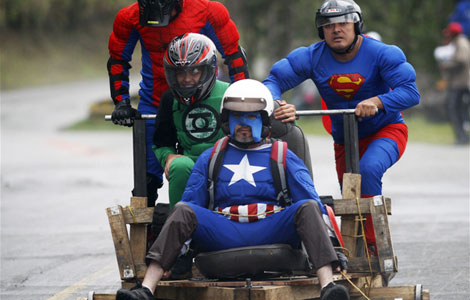

Rushing for GDP growth, China has been undergoing a high-speed rail-building spree under the government's economic stimulus program. The national network is expected to hit the ceiling of 17,600 km by the end of 2015.
Concerns about safety, technology, ticket prices, passenger use and financial sustainability have drawn significant attention from the public and press recently.
However, the backhoes digging the first high-speed rail project in the US are telling a different story, not about GDP, but about the fate of a more than 100-year-old Chinatown in Fresno, California.

In the past few days, the California High-Speed Rail Authority began digging work at a parking lot in downtown Fresno, where tunnels and artifacts from an 1880s-era Chinatown were believed to lie buried.
These vestiges were in the path of the first 48 km of the planned high-speed route, which is thought to be a kind of trial balloon for a high-speed link connecting San Francisco and Los Angeles.
"The California High-Speed Rail Authority is finishing up the archaeological work going on in the Chinatown area of Fresno," Karen Massie, a spokeswoman for the authority said. "At this time, the authority does not have any future archaeological digs scheduled."
According to a statement provided by Massie, the authority will protect the natural and human environment while building the nation's first high-speed rail project because "the Federal National Historic Preservation Act serves as a guide to the preservation of cultural resources and historic properties".
Preliminary research by the authority's investigative team indicates that the area might have included a general store and other small businesses, a dance hall, several residences, a gambling hall, and possibly a network of tunnels, according to the statement.
The authority is not only conducting underground archeological investigations, but also recently participated in face-to-face meetings with local community leaders called by Chinatown Revitalization Inc.
"It's our history, it's Fresno's history, it's valuable history," said Kathy Omachi, founder of Chinatown Revitalization Inc. Having migrated from Japan, Omachi's family has lived in the area for three generations. Her father was born in Fresno's Chinatown, and her grandfather came to the area more than 100 years ago.
She said it is very important for Chinatown property owners, residents and community members to understand the impact of the high-speed rail system, particularly business owners.
It is because some business owners have been told that "you have a limited amount of time before you're bounced out of your place", she said.
Fresno's Chinatown was established in about 1870 and was the original home of ethnic groups in the Fresno valley. They included African-Americans, Armenians, Basques, Chinese, Japanese, Italians, Portuguese, Mexican-Americans, Greeks, Filipinos and Germans from Volga, Russia, she said.
Chinatown has been divided many times, she said, and usually by transportation.
The railroad was the first to divide the area, which cut off Chinatown from downtown. Then came the freeway, which "cut off residential streets. If you notice the alphabet jumps over there, people were moved out or driven out over time," Omachi said.
"Now we want to make sure that we have a say in what's going to happen with the high-speed rail," she said. "Any buildings that are being targeted for purchase, and possible destruction, we want some answers if a building has historic value."
Many people in the Chinatown neighborhood support her.
"We've heard on the news that it's just going to be great for everybody. We're going to have so many businesses around the station, and everyone is going to live happily ever after," resident Jeremy Broadski said. "Unfortunately, with a lot of these public works projects, that's not the case.
"And we're concerned about our town becoming a desert because we are unsure right now exactly what's being planned to be torn down, how access is going to be restricted in Chinatown, and exactly what type of consideration the community has in the planning and development," he said.
Benny Lee, a city council member at San Leandro in northern California, said, "Those involved need to determine the materiality of the facts and evidence of cultural heritage.
"I've visited towns that have had historic Asian populations and cultural artifacts which have intrigued many," he said.
"I wouldn't have known the history had there been no individuals who worked hard toward sustainable preservation."
Contact the writer at chenjia@chinadailyusa.com







